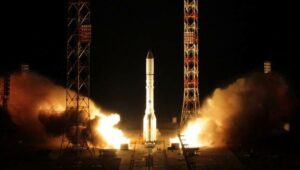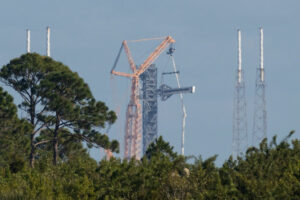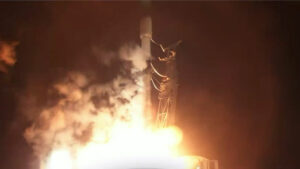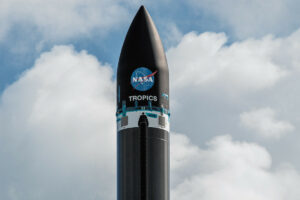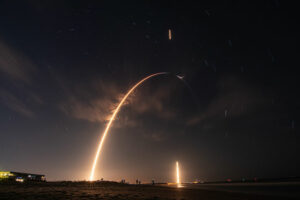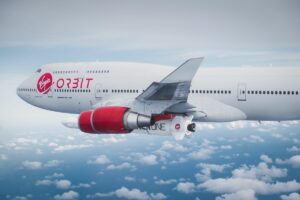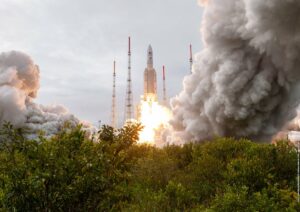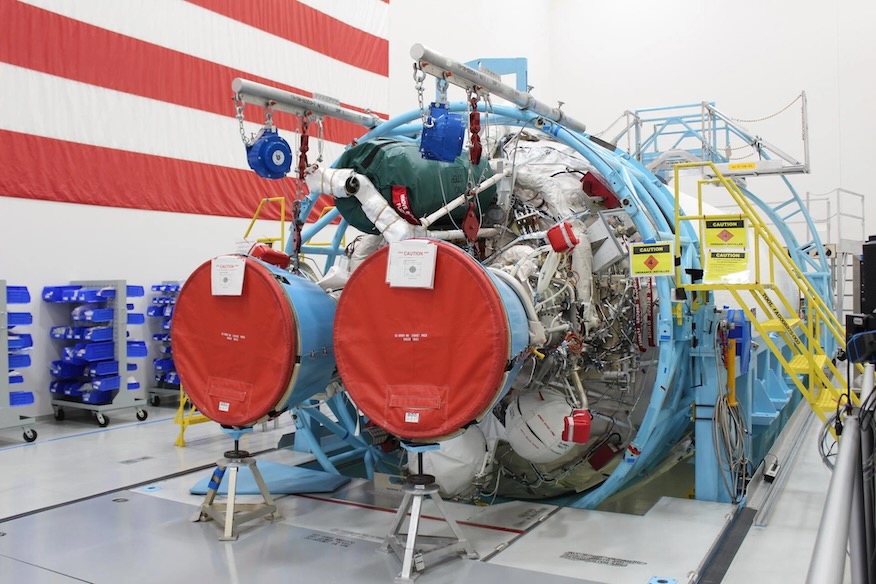
A rocket engine with a long pedigree marked a big milestone on Monday. It’s 60 years since the hydrogen-fueled RL10 engine debuted onboard a Centaur upper stage launched from Cape Canaveral on Nov. 27, 1963.
With that first launch, the RL10 engine, currently manufactured by Aerojet Rocketdyne, became the first engine powered by a combination of liquid hydrogen and liquid oxygen to be fired in space. The milestone came at a pivotal time for the United States, since it was just five days after the assassination of former President John F. Kennedy.
Since that point 60 years ago, 522 RL10 engines have flown in space, with the lion’s share of those flights aboard United Launch Alliance’s (ULA) Delta and Atlas rockets. These engines power the Delta Cryogenic Second Stage and Centaur upper stage respectively.
“Centaur and the RL10 have made it possible for us to launch spacecraft at greater size and weight over any of the other upper stage designs in use,” said Gary Wentz, ULA vice president of government and commercial programs, during a media event celebrating the milestone. “It has delivered fantastic missions to the Sun, our Moon, asteroids, every planet in the [solar] system.”
The engine was developed by Pratt & Whitney in the late 1950s through the oversight of NASA’s Lewis Research Center, which was renamed the NASA John H. Glenn Research Center at Lewis Field in 1999. Centaur was originally developed by General Dynamics.

The combination helped prove the viability of liquid oxygen and liquid hydrogen as a propellant combination for future launch vehicles. The RL10s themselves would go on to be used aboard the Saturn 1, Atlas, Titan and Delta rockets.
The engine also enjoyed use onboard the experimental suborbital vehicle, the DC-X, which was used by NASA and the Department of Defense to demonstrate a vertical rocket landing.
“It’s very exciting to be at 60 years and it’s a testament to the incredible teamwork that’s gone on between Aerojet Rocketdyne and ULA over all these years, a testament to all the people who worked on this product all these years and an incredible design that was originally laid out in the lat 1950s,” said Jim Maus, Aerojet Rocketdyne vice president of program execution and integration.
Maus said despite the successes they’ve seen over hundreds of engine flights, they continue to lean on ULA’s motto of focusing on launching one at a time.
“When we go to launch day, we’re very focused on that day’s launch,” Maus said. “And so, when you come to a big milestone, you kind of stand back and recognize, you know, look at all that we’ve done. So, it’s great to be part of the team that does that and we’re really thrilled to be at 60 years.”

Evolving the RL10
Currently, there are two variants of the RL10 in use: the RL10C-1-1 on ULA’s Atlas rockets and the RL10B-2, which is used on the ULA Delta 4 Heavy and NASA Space Launch System (SLS) rockets.
The latter variant has a limited life though since there is only one more Delta 4 Heavy rocket, which is scheduled to launch in 2024 on a mission for the National Reconnaissance Office (NRO). A single RL10B-2 is also used on the SLS’s Interim Cryogenic Propulsion Stage (ICPS) for the first three Artemis missions to the Moon.
Later versions of the SLS will use the Exploration Upper Stage, which is being engineered by Boeing. That will be powered by four RL10C-3 engines, which together will provide more than 97,000 pounds (431kN) thrust. For comparison, the single RL10B-2 on the Artemis 1 ICPS produced about 24,750 pounds (110kN) of thrust.
To date, Maus said there have been eight major upgrades of the RL10 engine. The next major iteration of the engine, the RL10C-X, which is still in development, will power future version of ULA’s forthcoming Vulcan rocket.
The biggest change seen with this version of the engine comes through its use of additive manufacturing techniques, more commonly known as 3D printing.
“We’re already flying the RL10 with an additive manufactured injector, but now we’re doing an additive manufactured thrust chamber and we’re going through that certification right now,” Maus said. “That engine will be delivering the highest performance of what we have available in protection today and will extend the life of the RL10 into the future.”

Maus added that the new production techniques will also bring cost savings, but declined to go into specifics on the drivers of the cost reduction.
“It’s been a significant improvement in cost on the chamber of the engine. We’re also putting a large carbon silicone nozzle on it, that’s pushing up the ISP to give us good performance,” Maus said. “And then, the turbo machinery and what I’ll call the powerhead and the backbone of the engine is identical to what we’ve been flying on the balance of the inventory. So, that it’s going to continue to delver the very high reliability on day one, launch one.”
The specific date of launch one still remains TBD, but Maus said they’re aiming to debut the RL10C-X in 2025 on a ULA Vulcan rocket. That said, Maus noted that they have orders for the current RL10C-1-1 engines through 2026.
Both NASA and ULA are driving what Maus described as a backlog of more than 150 engines, which are a combination of the legacy versions as well as the X-C variants with the additive manufactured features. He said NASA is still making a determination on whether they want to purchase more of the legacy engines or begin to buy engines using the additive manufacturing technology for future Artemis missions.
In a typical year, Maus said Aerojet Rocketdyne produces between 16 and 18 engines, but with the incorporation of more additive manufacturing into their production line, they’re ramping up to 40 engines annually.
“We quickly recognized that by 3D printing the combustion chamber, we could really make a big change to the cost of the engine and the reliance on hand fabricators,” Maus said. “So, moving away from the stainless steel fabrication to the 3D printed copper, we’re able to now build geometries we couldn’t have built otherwise with additive manufacturing. And then, we’re able to produce the engine now with the high volumes and the high rates that ULA needs.”
Classic engine, new rocket
In less than a month, ULA plans to debut its Vulcan rocket. The mission, dubbed Vulcan Cert-1, will use a pair of RL10C-1-1A engines to power the Centaur 5 upper stage and send Astrobotic’s Peregrine lunar lander on its way to the Moon.
After shipping an upgraded Centaur 5 from its factory in Decatur, Alabama, ULA integrated upper stage onto the Vulcan booster on Nov. 19. The mission is set to fly no earlier than Dec. 24, 2023.

ULA is preparing for a wet dress rehearsal in the first half of December during which the fully integrated Vulcan rocket will be rolled out to the launch pad and fueled as it if were launching. Maus said Aerojet Rocketdyne engineers will be on headsets during that fueling test to monitor the Centaur and how the engine is cooled and conditioned as it will be on launch day.
“We have engineers looking at all the data coming off the engine during wet dress rehearsal and we can pretty much understand in real time that everything is going right,” Maus said. “But then of course, there’s a data review that’ll come after that to ensure that everything performed as required.”
Ron Fortson, the director and general manager of launch operations for ULA, said they will then roll the rocket out to the launch pad the day before liftoff and get on console to begin the countdown about 12 hours ahead of time.
Fortson said integrating the RL10C-1-1A with the Vulcan vehicle went smoothly.
“Everything went well in our production facility and then here, it already comes fully assembled and we just mate it with our rocket and we’re ready to go,” Fortson said. “So, it’s been a great activity.”
Fortson said he and the team at ULA have been working closely with Aerojet Rocketdyne as they work towards the debut of the RL10C-X engine in a couple of years.

“We’re working very closely with them on their design and their testing. Once that’s all completed, we’ll be looking forward to actually just integrating it onto our Vulcan rocket,” Fortson said. “And then of course, we’ll be looking at all of our missions that are coming forward in terms of what those requirements are and making sure we can satisfy those requirements with this new engine.”
He said there likely won’t be a particular flight profile that will required for the debut of the RL10C-X on Vulcan, adding that “This engine’s going to be capable of doing anything we need it to do.”
“I think whatever requirements we have for it, we’re confident that this engine will be able to satisfy it,” Fortson said.
“We have a philosophy of test like you fly, which means the engine will only see in flight that which it has experienced on the ground within the limits of what we can test or analyze,” Maus said. “So, we’ve been through all of that testing over the last several years to understand how the engine operates in the Vulcan scheme.”
Maus said as they look forward to flying the RL10 on new rockets and in new iterations, they look forward to another key milestone: flying humans via the Commercial Crew and the Artemis programs.
“We’ve been bringing astronauts down to West Palm Beach, to our facility to talk to our team about the reality of what we deliver and it’s very motivating for us to see our passengers standing in front of the room, telling us about how much they’re relying upon us,” Maus said. “But the reality is, we design and build a highly reliable product and it has demonstrated its reliability.”
- SEO Powered Content & PR Distribution. Get Amplified Today.
- PlatoData.Network Vertical Generative Ai. Empower Yourself. Access Here.
- PlatoAiStream. Web3 Intelligence. Knowledge Amplified. Access Here.
- PlatoESG. Carbon, CleanTech, Energy, Environment, Solar, Waste Management. Access Here.
- PlatoHealth. Biotech and Clinical Trials Intelligence. Access Here.
- Source: https://spaceflightnow.com/2023/11/28/aerojet-rocketdyne-ula-mark-60th-anniversary-of-rl10-rocket-engine/
- :has
- :is
- $UP
- 000
- 1
- 12
- 150
- 16
- 19
- 1999
- 2023
- 2024
- 2025
- 2026
- 24
- 27
- 3d
- 3D Printing
- 40
- 60
- 750
- 97
- a
- Able
- About
- activity
- actually
- added
- adding
- additive
- additive manufacturing
- adjacent
- After
- ago
- ahead
- Aiming
- Alabama
- All
- Alliance
- already
- also
- an
- analyze
- and
- Anniversary
- Annually
- Another
- any
- anything
- ARE
- Artemis
- AS
- assembled
- asteroids
- At
- atlas
- available
- away
- back
- Backbone
- Balance
- BE
- Beach
- became
- been
- before
- begin
- being
- between
- Big
- Biggest
- Boeing
- booster
- bring
- Bringing
- build
- built
- but
- buy
- by
- call
- came
- CAN
- capable
- cape
- carbon
- Celebrating
- Center
- Certification
- Chamber
- change
- closely
- combination
- come
- comes
- coming
- commercial
- commonly
- comparison
- Completed
- completion
- confident
- Console
- continue
- Copper
- Cost
- cost reduction
- cost savings
- could
- countdown
- Couple
- course
- crew
- cryogenic
- Current
- Currently
- data
- Date
- day
- Days
- debut
- debuted
- December
- Defense
- deliver
- delivered
- delivering
- Delta
- demonstrate
- demonstrated
- Department
- department of defense
- described
- Design
- designs
- Despite
- determination
- developed
- Development
- differences
- Director
- do
- does
- doing
- done
- down
- drivers
- driving
- dubbed
- during
- dynamics
- Earlier
- Engine
- engineered
- Engineers
- Engines
- ensure
- Ether (ETH)
- Event
- Every
- everything
- exciting
- execution
- experienced
- experimental
- exploration
- extend
- Facility
- factory
- fantastic
- Features
- field
- fired
- First
- five
- flight
- Flights
- flying
- focused
- focusing
- For
- Force
- Former
- forthcoming
- Forward
- four
- from
- front
- fueled
- fully
- future
- Gary
- General
- get
- Give
- Go
- going
- gone
- good
- Government
- graphic
- great
- greater
- Ground
- Half
- hand
- Have
- he
- headsets
- heavy
- helped
- here
- High
- highest
- highly
- HOURS
- How
- http
- HTTPS
- Humans
- Hundreds
- hydrogen
- I’LL
- identical
- if
- illustrating
- image
- improvement
- in
- Inaugural
- incredible
- infographic
- integrated
- Integrating
- integration
- interim
- into
- inventory
- ISP
- IT
- iteration
- iterations
- ITS
- Jim
- John
- jpg
- just
- Key
- key milestone
- Kind
- Know
- known
- landing
- large
- Last
- Late
- launch
- launched
- launching
- Legacy
- less
- Lewis
- Life
- like
- likely
- Limited
- limits
- Line
- Liquid
- Long
- Look
- looking
- Lunar
- lunar lander
- machinery
- made
- major
- make
- Making
- manager
- manufactured
- manufacturing
- mark
- marked
- mate
- max-width
- means
- Media
- milestone
- Mission
- missions
- model
- Monday
- Monitor
- Month
- Moon
- more
- Motto
- moving
- much
- Nasa
- National
- Need
- needs
- New
- next
- no
- noted
- nov
- November
- now
- of
- off
- Office
- on
- Onboard
- once
- ONE
- only
- operates
- Operations
- or
- orders
- originally
- Other
- otherwise
- our
- out
- over
- Oversight
- Oxygen
- pad
- pair
- palm
- part
- particular
- People
- performance
- performed
- philosophy
- pivotal
- planet
- plans
- plato
- Plato Data Intelligence
- PlatoData
- Point
- possible
- pounds
- power
- powered
- preparing
- president
- pretty
- printing
- produce
- Produced
- produces
- Product
- Production
- Profile
- Program
- Programs
- propulsion
- protection
- Prove
- provide
- purchase
- Pushing
- Putting
- quickly
- ramping
- Rates
- ready
- real
- real-time
- Reality
- really
- recognize
- recognized
- reduction
- rehearsal
- reliability
- reliable
- reliance
- relying
- remains
- required
- Requirements
- research
- respectively
- review
- right
- rocket
- Roll
- Rolled
- Room
- Said
- Saturn
- Savings
- scheduled
- scheme
- Second
- see
- seen
- send
- set
- several
- Share
- Shipping
- significant
- silicone
- since
- single
- Size
- smoothly
- So
- solar
- Space
- Space Force
- spacecraft
- specific
- specifics
- Stage
- stages
- Stainless Steel
- stand
- standing
- States
- station
- steel
- Still
- successes
- successful
- Sun
- sure
- system
- Talk
- team
- teamwork
- techniques
- Technology
- telling
- terms
- test
- testament
- tested
- Testing
- than
- that
- The
- The Future
- their
- Them
- themselves
- then
- There.
- These
- they
- think
- this
- those
- though?
- three
- thrilled
- Through
- thrust
- time
- titan
- to
- today
- together
- towards
- two
- typical
- understand
- United
- United States
- upgraded
- upgrades
- upon
- us
- use
- used
- using
- Variant
- vehicle
- Vehicles
- version
- vertical
- very
- via
- viability
- vice
- Vice President
- volumes
- vulcan
- want
- was
- Way..
- we
- weight
- WELL
- went
- were
- West
- What
- whatever
- when
- whether
- which
- while
- WHO
- will
- with
- within
- Work
- worked
- working
- would
- year
- years
- you
- zephyrnet

